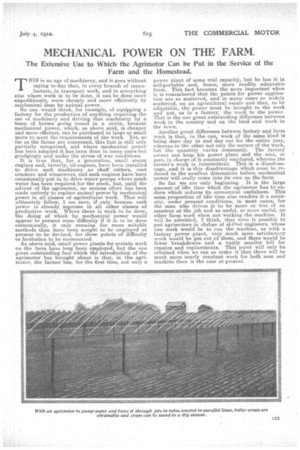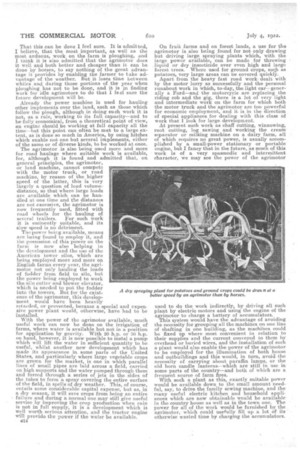MECHANICAL POWER ON THE FARM.
Page 9

Page 10

If you've noticed an error in this article please click here to report it so we can fix it.
The Extensive Use to Which the Agrimotor Can be Put in the Service of the Farm and the Homestead.
THIS is an age of machinery, and it goes without saying to-day that, in every branch of manufacture, in transport work, and in everything else where work is to be done, it can. be done more expeditiously, more cheaply and more efficiently by mechanical than by animal power.
No one would thiuk, for example, of equipping a factory for the production of anything requiring the use of machinery and driving that machinery by a team of horses going round in a circle, because mechanical power, which, as above said, is cheaper and more efficient, can be purchased in large or small units to meet the requirements of the work, Yet, so far as the farms are concerned, this fact is still only partially recognized, and where mechanical power has been adopted it has been done in many cases but grudgingly and under the stress of war conditions. It is true that, for a generation, small steam engines and, latterly, oil-engines, have been installed to drive such machinery as chaff cutters, root crushers and winnowers, and such engines have been occasionally put in to drive water pumps where much water has been required for the stock, but, until the advent of the agrimotor, no serious effort has been made entirely to replace animal power by mechanical power in all classes of agricultural work. That will ultimately follow, I am sure, if only because such power is already supreme in all other classes of productive work. Where there is work to be done, the doing of which by mechanieal power would appear to present some difficulty if it is to be done economically, it only remains for more suitable methods than have been sought to be employed at present tobe devised, for these points of difficulty or hesitation to be surmounted.
As above said, small power plants for -certain work on the farm have long been employed, but the one great outstanding fact which the introduction of the agrimotar has brought about is that, in the a,grimotor, the farmer has, for the first time, not only a
power plant of some real capacity, but he hasit in self-portable and, hence, more readily adaptable form. This fact becomes the more important when it is remembered that the points for power application are SG mattered, and in many eases so widely scattered, on an agricultural estate and that, to be adaptable, the power must be. brought to the work and not, as in a factory, the work to the power. That is the one great outstanding difference between work in the country and on the land andwork in the town.
Another great difference between factory and farm work is that, in the one, work of the same kind is being done day in and day out for the entire year, whereas in the other not only the nature of the work, but the quantity varies constantly. The factory owner can keep his power plant and the man, or men, in charge of it constantly employed, whereas the farmer's work is intermittent. This is a disadvantage and it is this disadvantage which must be reduced to the smallest dimensions before mechanical power will really come into its own on the farm.
So far we are only beginning. It is the large amount of idle time which the a.grimotor has. to endure which reduces its economical usefulness. This same proportion of idle time also renders it a necessity, under present conditions, in most cases, for the man who drives it to be more or less of an amateur at the job and as useful, or more useful, on other farm work when not working the machine. It will be admitted, I think, that were it possible to put agrirnotors in charge of skilled engineers, whose one work would be to run the machine, as with a factory power plant, very much more satisfactory, work would be got out of them, and there would be fewer breakdowns and a vastly smaller bill for repairs and replacements. This point will only be attained when we can so order it that there will be much more nearly constant work for both man and machine than is the case at present.
That this can be done I feel sure. It is admitted, I believe, that the most important, as well as the most arduous, work on the farm is ploughing, and I think it is also admitted that the agrimotor does it well and both better and cheaper than it can be done by horses, to say nothing of the great advantage it provides by enabling the farmer to take advantage of the weather. But it loses time between whiles and during those portions of the year when ploughing has not to be done, and it is in finding work for idle agrimotors to do that I feel sure the future development will be.
Already the power maehine is used for hauling other implements over the land, such as those which follow the plough, although in doing such work it is not, as a rule, working to its full capacity—and to be-fully economical, from a theoretical point of view, an engine should be working at full capacity all the time—but this point can often be met to a large extent, as is done so much in America, by using hitches which enable not one but several implements, either of the same or of diverse kinds, to be worked at once.
The agrimotor is also being used more and more for road haulage where suitable work is available, for, although it is found and admitted that, on general principles, the agrimotor, or land machine, cannot compete with the Motor truck, or road machine, by reason of the higher speed of the latter, this is very largely a question of load volume.. distance, so that where large loads are available which can be handled at one time and the distances are not excessive, the agrimotor is now frequently used, fitted with road wheels for the hauling of several trailers. For such work it is eminently suitable, and its slow speed is no detriment.
The power being available, means are being found to employ it, and the possession of this power On the farm is now also helping in the development and the use of the American tower silos, which are being employed more and more on English farms every year, the agrimotor not only hauling the loads of fodder from field to silo, but the power being employed to work the silo cutter and blower elevator, which is needed to put the fodder into the towers. But for the existence of the agrimotor, this developPient would have been heavily retarded, or prevented, because a special and expen. sive power plant would, otherwise, have had to be installed.
With the power of the agrimotor available, much useful work can now be done on the irrigation of farms, where water is available but not in a position for application by gravity. With 20 h.p. or 30 h.p. on hand, however, it is now possible to instal a pump which will lift the water in aufficient quantity to he useful, whilst another new development which has made its appearance in some parts of the United States, and particularly where large vegetable crops are grown for the market, is one in which parallel lines of small pipes are laid across a field, carried on high supports and the water pumped through them and forced through a series of jets in the sides of the tubes to form a spray covering the entire surface of the field, in spells of dry weather. This, of course, entails some considerable capital expense, but as, in a, dry season, it will save crops from being an entire failure and during a normal one may still give useful service by improving the crop production when rain is not in full supply, it is a development which is well worth serious attention, and the tractor engine will provide the power if the water be available.
On fruit farms and on forest lands, a use for the agrimotor is also being found for not only drawing but driving large spraying plants which, with the large power available, can be made for throwing liquid or dry insecticide over even high and large forest trees. Where used for ground crops, such as potatoes, very large areas can be covered quickly.
Apart from the heavy fast road work. dealt with by the motor lorry so successfully and the personal runabout work in which, to-day, the light car—generally a Ford—and the motorcycle are replacing the riding cob and the gig, there is a lot of very light and intermediate work on the farm for which both the motor truck and the agrimotor are too powerful for economic employment, and it is in the direction of special appliances for dealing with this class of work that I look for large development.
At present such work as chaff cutting, -winnowing, root cutting, log sawing and working the cream separator or milking machine on a dairy farm, all of which requires no great power, is usually accomplished by a small-power stationary or portable engine, but I fancy that in the future, as much of this
i work s of a very spasmodic and intermittent character, we may see the power of the agrimotor
used to do the work indirectly, by driving all such plant by electric motors and using the engine of the agrimotor to charge a battery of accumulators.
This system would have the advantage of avoiding the necessity for grouping all the machines on one line of shafting in one building, as the machines could he fixed up where most convenient in relation to their supplies and the current conveyed to them by overhead or buried wires, and the installation of such a plant would also enable the power of the agrimotor to be employed for the illumination of both house and outbuildings and this would, in turn, avoid the necessity of carrying about paraffin lamps, or the old horn candle lanterns—which are still in use in some parts of the country—and both of which are a frequent source of farm fires. With such a plant as this, exactly suitable power would be available down to the small amount needful, say, to drive the family sewing machine, and the many useful electric kitchen and household appliances which are now obtainable would be available in the country house as well as in the town one. The power for all of the work would be furnished by the agrimotor, which could usefully fill up a lot of its otherwise wasted time by charging the accumulators.








































